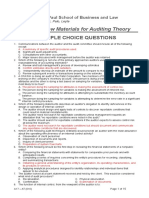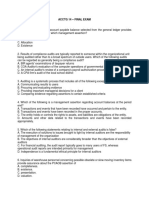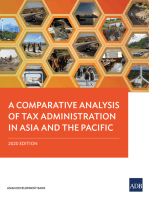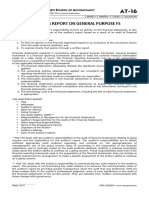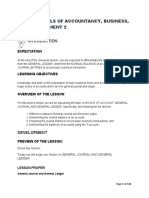Audit Theory 3 Accounting
Audit Theory 3 Accounting
Uploaded by
randomlungs121223Copyright:
Available Formats
Audit Theory 3 Accounting
Audit Theory 3 Accounting
Uploaded by
randomlungs121223Original Title
Copyright
Available Formats
Share this document
Did you find this document useful?
Is this content inappropriate?
Copyright:
Available Formats
Audit Theory 3 Accounting
Audit Theory 3 Accounting
Uploaded by
randomlungs121223Copyright:
Available Formats
lOMoARcPSD|35846740
Audit Theory 3 - Accounting
Accountancy (STI College)
Scan to open on Studocu
Studocu is not sponsored or endorsed by any college or university
Downloaded by random (randomlungs121223@gmail.com)
lOMoARcPSD|35846740
1. Opportunities to misappropriate assets increase when there are
A. Known or anticipated future employee layoffs.
B. Promotions, compensation, or other rewards inconsistent with expectations.
C. Recent or anticipated changes to employee compensation or benefit plans.
D. Inventory items that are small in size, of high value, or in high
demand.
2. The following are benefits of using IT-based controls, except
A. Ability to process large volume of transactions.
B. Over-reliance on computer-generated reports.
C. Ability to replace manual controls with computer-based controls.
D. Reduction in misstatements due to consistent processing of transactions.
3. Which of the following is a false statement about audit objectives?
A. There should be a one-to-one relationship between audit objectives
and procedures.
B. Audit objectives should be developed in light of management assertions
about the financial statement components.
C. Selection of tests to meet audit objectives should depend upon the
understanding of internal control.
D. The auditor should resolve any substantial doubt about any of management’s
material financial statement assertions.
4. According to Section 240 of the Code of Ethics, fees charged for assurance
engagements should be a fair reflection of the value of the work involved. In
determining professional fees, the following should be taken into account,
except
A. The time necessarily occupied by each person engaged on the work.
B. The outcome or result of a transaction or the result of the work
performed.
C. The skill and knowledge required for the type of work involved.
D. The level of training and experience of the persons necessarily engaged on
the work.
5. Financial interests may be held through an intermediary (for example, a
collective investment vehicle, estate or trust). When control over the
investment vehicle or the ability to influence investment decisions exists, the
code defines that financial interest to be
A. Direct financial interest.
B. Material direct financial interest.
C. Indirect financial interest.
D. Material indirect financial interest.
6. Which of the following best describes the reason why independent auditors
report on financial statements?
A. A management fraud may exist and it is more likely to be detected by
independent auditors.
B. Different interests may exist between the company preparing the
statements and the persons using the statements.
Downloaded by random (randomlungs121223@gmail.com)
lOMoARcPSD|35846740
C. A misstatement of account balances may exist and is generally corrected as
the result of the independent auditors’ work.
D. Poorly designed internal control may be in existence.
6. Which of the following professionals has primary responsibility for the
performance of an audit?
A. The managing partner of the firm.
B. The senior assigned to the engagement.
C. The manager assigned to the engagement.
D. The partner in charge of the engagement.
7. What is the proper organizational role of internal auditing?
A. To serve as an independent, objective assurance and consulting
activity that adds value to operations.
B. To assist the external auditor in order to reduce external audit fees.
C. To perform studies to assist in the attainment of more efficient operations.
D. To serve as the investigative arm of the audit committee of the board of
directors.
8. If the results of the auditor’s expert’s work do not provide sufficient appropriate
audit evidence or are not consistent with other audit evidence, the auditor
should
A. Report the matter to the appropriate regulatory agency of the government.
B. Resolve the matter.
C. Withdraw from the engagement.
D. Express an unqualified opinion with reference to the work of the expert.
9. A measure of how willing the auditor is to accept that the financial statements
may be materially misstated after the audit is completed and an unmodified opinion
has been issued is the
A. Inherent risk.
B. Acceptable audit risk.
C. Control risk.
D. Detection risk.
10. An auditor should obtain sufficient knowledge of an entity’s information
system, including the related business processes relevant to financial
reporting, to understand the
A. Policies used to detect the concealment of fraud.
B. Process used to prepare significant accounting estimates.
C. Safeguards used to limit access to computer facilities.
D. Procedures used to assure proper authorization of transactions.
11. Which of the following is an example of engagement-specific safeguards in the
work environment?
A. Advising partners and professional staff of those assurance clients and related
entities from which they must be independent.
B. Disclosing to those charged with governance of the client the nature
of service provided and extent of fees charged.
Downloaded by random (randomlungs121223@gmail.com)
lOMoARcPSD|35846740
C. A disciplinary mechanism to promote compliance with the firm’s policies and
procedures.
D. Published policies and procedures to encourage and empower staff to
communicate to senior levels within the firm any issue relating to compliance
with the fundamental principles that concerns them.
12. The concept of materiality is least important to an auditor when considering
the
A. Effects of a direct financial interest in the client upon the auditor’s
independence.
B. Decision whether to use positive or negative confirmations of accounts
receivable.
C. Adequacy of disclosure of a client’s illegal act.
D. Discovery of weaknesses in a client’s internal control.
13. The following statements relate to the provision of taxation, internal audit or IT
Systems services to audit clients. Which is false?
A. Preparing calculations of current and deferred tax liabilities (or
assets) for an audit client for the purpose of preparing accounting
entries that will be subsequently audited by the firm creates a self-
interest threat.
B. A self-review threat may be created when a firm, or network firm, provides
internal audit services to an audit client.
C. The provision of services by a firm or network firm to an audit client that
involve the design and implementation of financial information technology
systems that are used to generate information forming part of a client’s
financial statements may create a self-review threat.
D. The provision of services in connection with the assessment, design, and
implementation of internal accounting controls and risk management controls
does not create a threat to independence provided that firm or network firm
personnel do not perform management functions.
14. hat threat to independence is created when the litigation support services
provided to an audit client include the estimation of the possible outcome and
thereby affects the amounts or disclosures to be reflected in the financial
statements?
A. Self-review threat
B. Advocacy threat
C. Intimidation threat
D. Familiarity threat
15. After determining that a related party transaction has, in fact, occurred, an
auditor should
A. Obtain an understanding of the business purpose of the transaction.
B. Substantiate that the transaction was consummated on terms equivalent to
an arm’s-length transaction.
C. Add a separate paragraph to the auditor’s report to explain the transaction.
D. Perform analytical procedures to verify whether similar transactions occurred,
but were not recorded.
Downloaded by random (randomlungs121223@gmail.com)
lOMoARcPSD|35846740
16. Which of the following audit procedures would most likely assist an auditor in
identifying conditions and events that may indicate there could be substantial
doubt about an entity’s ability to continue as a going concern?
A. Confirmation of bank balances.
B. Confirmation of accounts receivable from major customers.
C. Reconciliation of interest expense with debt outstanding.
D. Review of compliance with terms of debt agreements.
17. Who should take responsibility for the overall quality on each audit
engagement?
A. Engagement quality control reviewer
B. Engagement partner
C. Engagement team
D. CPA firm
17. The engagement partner should take responsibility for the direction,
supervision, and performance of the audit engagement in compliance with
professional standards and regulatory and legal requirements, and for the
auditor’s report that is issued to be appropriate in the circumstances.
Supervision includes the following, except
A. Tracking the progress of the audit engagement.
B. Addressing significant issues arising during the audit engagement,
considering their significance, and modifying the planned approach
appropriately.
C. Informing the members of the engagement team of their
responsibilities.
D. Identifying matters for consultation or consideration by more experienced
engagement team members during the audit engagement.
18. Analytical procedures performed in the overall review stage of an audit
suggest that several accounts have unexpected relationships. The results of
these procedures most likely indicate that
A. The communication with the audit committee should be revised.
B. Irregularities exist among the relevant account balances.
C. Additional substantive tests of details are required.
D. Internal control activities are not operating effectively.
19. When an auditor concludes that there is substantial doubt about a continuing
audit client’s ability to continue as a going concern for a reasonable period of
time, the auditor’s responsibility is to
A. Consider the adequacy of disclosure about the client’s possible
inability to continue as a going concern.
B. Issue a qualified or adverse opinion, depending upon materiality, due to the
possible effects on the financial statements.
C. Report to the client’s audit committee that management’s accounting
estimates may need to be adjusted.
D. Reissue the prior year’s auditor’s report and add an emphasis of matter
paragraph that specifically refers to “substantial doubt” and “going concern.”
Downloaded by random (randomlungs121223@gmail.com)
lOMoARcPSD|35846740
20. The following statements relate to the provision of legal services to an audit
client. Which is incorrect?
A. The provision of legal services to an audit client involving matters
that would not be expected to have a material effect on the financial
statements may create a self-review threat.
B. Legal services to support an audit client in the execution of a transaction
(e.g., contract support) may create a self-review threat.
C. Acting for an audit client in the resolution of a dispute or litigation in such
circumstances when the amounts involved are material in relation to the
financial statements of the audit client would create advocacy and self-review
threats so significant no safeguards could reduce the threats to an acceptable
level.
D. The appointment of a partner or an employee of the firm or network firm as
General Counsel for legal affairs to an audit client would create self-review and
advocacy threats that are so significant no safeguards could reduce the threats
to an acceptable level.
Downloaded by random (randomlungs121223@gmail.com)
You might also like
- AuditingDocument8 pagesAuditingNan Laron ParrochaNo ratings yet
- Auditing Draft PDFDocument17 pagesAuditing Draft PDFJerry PinongpongNo ratings yet
- Questions and AnswersDocument20 pagesQuestions and AnswersJi YuNo ratings yet
- Auditing in A CIS EnvironmentDocument11 pagesAuditing in A CIS EnvironmentPaul Anthony AspuriaNo ratings yet
- AT ReviewerDocument10 pagesAT Reviewerfer maNo ratings yet
- Aaconapps2 00-C91pb1aDocument17 pagesAaconapps2 00-C91pb1aJane DizonNo ratings yet
- 91-Aud First Pb-AudDocument12 pages91-Aud First Pb-Audjohn paulNo ratings yet
- Aud TheoryDocument9 pagesAud TheoryYaj CruzadaNo ratings yet
- Ap 01 Overview of The Audit ProcessDocument6 pagesAp 01 Overview of The Audit ProcessYoung MetroNo ratings yet
- AUD ReviewerDocument9 pagesAUD ReviewerMhaybelle JovellanoNo ratings yet
- Midterm Specialized IndustriesDocument9 pagesMidterm Specialized IndustriesAmie Jane Miranda50% (2)
- AUDITTHEODocument13 pagesAUDITTHEOAlisonNo ratings yet
- AUDITINGDocument20 pagesAUDITINGAngelieNo ratings yet
- Audtbans 5Document7 pagesAudtbans 5John DoesNo ratings yet
- Answer Key: Audit Planning, Understanding The Client, Assessing Risks, and RespondingDocument15 pagesAnswer Key: Audit Planning, Understanding The Client, Assessing Risks, and RespondingRizza OmalinNo ratings yet
- Auditing Theory ComprehensiveDocument14 pagesAuditing Theory ComprehensiveMary GarciaNo ratings yet
- AT-08-Understanding of Entity's Internal ControlDocument4 pagesAT-08-Understanding of Entity's Internal Control7N GizonNo ratings yet
- CPARDocument16 pagesCPARstellajero624No ratings yet
- Inbound 6206923241467376385Document6 pagesInbound 6206923241467376385Lovely Jean SamaritaNo ratings yet
- AT ComprehensiveDocument15 pagesAT ComprehensiveXulian ChanNo ratings yet
- Audtbans 1Document7 pagesAudtbans 1John DoesNo ratings yet
- 94-Final PB-AUD - UnlockedDocument13 pages94-Final PB-AUD - UnlockedJessaNo ratings yet
- Auditing 2nd Sem AY 2020-2021 Institutional Mock Board ExamDocument10 pagesAuditing 2nd Sem AY 2020-2021 Institutional Mock Board ExamGet BurnNo ratings yet
- Question in Auditing TheoryDocument20 pagesQuestion in Auditing TheoryJeric YangNo ratings yet
- Considerations of Internal Control Psa-Based QuestionsDocument28 pagesConsiderations of Internal Control Psa-Based QuestionsNoro88% (8)
- Audit Theo FPB With Answer KeysDocument6 pagesAudit Theo FPB With Answer KeysPj Manez100% (1)
- Auditing Theory Comprehensive Exam - Jan2021Document16 pagesAuditing Theory Comprehensive Exam - Jan2021Aireen MacapangalNo ratings yet
- 2012 Planning - ExamDocument21 pages2012 Planning - ExamLaura McCubbinNo ratings yet
- Audit Theory Comprehensive Test - Set BDocument8 pagesAudit Theory Comprehensive Test - Set BTrisha Mae AlburoNo ratings yet
- Review Materials For Auditing Theory: Multiple Choice QuestionsDocument16 pagesReview Materials For Auditing Theory: Multiple Choice QuestionsDanica PelenioNo ratings yet
- Auditing TheoryDocument12 pagesAuditing TheorymilleranNo ratings yet
- Chapter 7Document17 pagesChapter 7hajymNo ratings yet
- At Final Pre BoardDocument4 pagesAt Final Pre BoardAira Mae CachoNo ratings yet
- LT1 Assurance IntroductionDocument9 pagesLT1 Assurance IntroductionAbs PangaderNo ratings yet
- Questions 1-25Document11 pagesQuestions 1-25bonnyme.00No ratings yet
- AT - Diagnostic Examfor PrintingDocument8 pagesAT - Diagnostic Examfor PrintingMichaela PortarcosNo ratings yet
- Audit Assessment True or False and MCQ - CompressDocument8 pagesAudit Assessment True or False and MCQ - CompressHazel BawasantaNo ratings yet
- 92-FIRST PB-AUD ExamDocument11 pages92-FIRST PB-AUD ExamReynaldo corpuzNo ratings yet
- Aaconapps2 00-C92pb1aDocument14 pagesAaconapps2 00-C92pb1aJane DizonNo ratings yet
- Questionnaires Aud Theory FinalDocument18 pagesQuestionnaires Aud Theory FinalRandy PaderesNo ratings yet
- Acctg 14 Final ExamDocument8 pagesAcctg 14 Final ExamErine100% (1)
- Quiz 1 & 2 (Aud) - MarcoletaDocument4 pagesQuiz 1 & 2 (Aud) - MarcoletaLeane MarcoletaNo ratings yet
- Practice PeDocument12 pagesPractice PeRhea EnocNo ratings yet
- Question Excerpt From Auditing TheoryDocument7 pagesQuestion Excerpt From Auditing TheoryHoney LimNo ratings yet
- Auditing Theory ChallengeDocument15 pagesAuditing Theory ChallengeMikaela Graciel AnneNo ratings yet
- NFJPIA Mockboard 2011 Auditing TheoryDocument6 pagesNFJPIA Mockboard 2011 Auditing TheoryKathleen Ang100% (1)
- Auditing Theory MULTIPLE CHOICE. Read Carefully The Questions Below and Choose The Best Statement Among The ChoicesDocument12 pagesAuditing Theory MULTIPLE CHOICE. Read Carefully The Questions Below and Choose The Best Statement Among The Choiceschimchimcoli100% (1)
- Acc 110 Week 1 Learning ActivityDocument5 pagesAcc 110 Week 1 Learning Activitycarla tanesNo ratings yet
- 1st AudPB-89th-FEB 2021Document13 pages1st AudPB-89th-FEB 2021Ziee00No ratings yet
- AUDDocument20 pagesAUDJay GamboaNo ratings yet
- At MCQ Salogsacol Auditing Theory Multiple ChoiceDocument32 pagesAt MCQ Salogsacol Auditing Theory Multiple Choicealmira garciaNo ratings yet
- CEBU CPAR CENTER - 1st PreboardDocument24 pagesCEBU CPAR CENTER - 1st PreboardMary Alcaflor BarcelaNo ratings yet
- Annual Update and Practice Issues for Preparation, Compilation, and Review EngagementsFrom EverandAnnual Update and Practice Issues for Preparation, Compilation, and Review EngagementsNo ratings yet
- Audit Risk Alert: General Accounting and Auditing Developments 2018/19From EverandAudit Risk Alert: General Accounting and Auditing Developments 2018/19No ratings yet
- Audit Risk Alert: General Accounting and Auditing Developments, 2017/18From EverandAudit Risk Alert: General Accounting and Auditing Developments, 2017/18No ratings yet
- Engagement Essentials: Preparation, Compilation, and Review of Financial StatementsFrom EverandEngagement Essentials: Preparation, Compilation, and Review of Financial StatementsNo ratings yet
- A Comparative Analysis of Tax Administration in Asia and the Pacific: 2020 EditionFrom EverandA Comparative Analysis of Tax Administration in Asia and the Pacific: 2020 EditionNo ratings yet
- Quiz 2Document20 pagesQuiz 2randomlungs121223No ratings yet
- IT Audit 4ed SM Ch10Document45 pagesIT Audit 4ed SM Ch10randomlungs121223No ratings yet
- Reo Consideration of Fraud Error and Noncompliance 9 14Document6 pagesReo Consideration of Fraud Error and Noncompliance 9 14randomlungs121223No ratings yet
- Auditing Theory Test Bank Escala - pdf-14-18Document5 pagesAuditing Theory Test Bank Escala - pdf-14-18randomlungs121223No ratings yet
- DocxDocument30 pagesDocxrandomlungs121223No ratings yet
- c3 ReviewerDocument42 pagesc3 Reviewerrandomlungs121223No ratings yet
- 1 Fundamentals of Auditing and Assurance Services RESADocument5 pages1 Fundamentals of Auditing and Assurance Services RESArandomlungs121223No ratings yet
- 06C Investment Property & Other InvestmentsDocument8 pages06C Investment Property & Other Investmentsrandomlungs121223No ratings yet
- 06A Investment in Equity Securities (Financial Assets at FMV, Investment in Associates)Document6 pages06A Investment in Equity Securities (Financial Assets at FMV, Investment in Associates)randomlungs121223100% (1)
- IT Audit 4ed SM Ch9Document62 pagesIT Audit 4ed SM Ch9randomlungs121223No ratings yet
- 04 Absorption & Variable Costing With Pricing DecisionsDocument6 pages04 Absorption & Variable Costing With Pricing Decisionsrandomlungs121223No ratings yet
- 08 Identifying & Assessing The Risks of Material MisstatementDocument5 pages08 Identifying & Assessing The Risks of Material Misstatementrandomlungs121223No ratings yet
- 02 Cost Behavior With Regression AnalysisDocument6 pages02 Cost Behavior With Regression Analysisrandomlungs121223No ratings yet
- 03 Cost-Volume-Profit AnalysisDocument6 pages03 Cost-Volume-Profit Analysisrandomlungs121223No ratings yet
- IT Audit CH 06Document23 pagesIT Audit CH 06randomlungs121223No ratings yet
- IT Audit 4ed SM Ch7Document10 pagesIT Audit 4ed SM Ch7randomlungs121223No ratings yet
- 10 Working Capital ManagementDocument13 pages10 Working Capital Managementrandomlungs121223No ratings yet
- 03 FS Audit OverviewDocument4 pages03 FS Audit Overviewrandomlungs121223No ratings yet
- IT Audit CH 09Document23 pagesIT Audit CH 09randomlungs121223No ratings yet
- 12 Capital Budgeting With Investment Risks and ReturnsDocument18 pages12 Capital Budgeting With Investment Risks and Returnsrandomlungs121223No ratings yet
- 10 Risk Assessment & Response To Assessed RisksDocument6 pages10 Risk Assessment & Response To Assessed Risksrandomlungs121223No ratings yet
- 19 Special Audit & Non-Audit ConsiderationsDocument7 pages19 Special Audit & Non-Audit Considerationsrandomlungs121223No ratings yet
- 18 Completing The AuditDocument7 pages18 Completing The Auditrandomlungs121223No ratings yet
- 15 Audit SamplingDocument7 pages15 Audit Samplingrandomlungs121223No ratings yet
- 11 Tests of ControlsDocument6 pages11 Tests of Controlsrandomlungs121223No ratings yet
- 16 Auditor's Report On General Purpose FSDocument4 pages16 Auditor's Report On General Purpose FSrandomlungs121223No ratings yet
- 07 FS Audit Process - Audit PlanningDocument6 pages07 FS Audit Process - Audit Planningrandomlungs121223No ratings yet
- Activity Answer KeyDocument7 pagesActivity Answer Keycindy pecañaNo ratings yet
- FAR Handout 03 - Trade ReceivablesDocument4 pagesFAR Handout 03 - Trade ReceivablesadieNo ratings yet
- On November I 2013 Campbell Corporation Management Decided To Discontinue PDFDocument1 pageOn November I 2013 Campbell Corporation Management Decided To Discontinue PDFFreelance WorkerNo ratings yet
- SIP ProjectDocument43 pagesSIP ProjectTina WaghmareNo ratings yet
- Special JournalDocument7 pagesSpecial JournalJohn Christopher Sta AnaNo ratings yet
- SAP Localization TurkeyDocument30 pagesSAP Localization Turkeybenhzb100% (1)
- Cecchetti 5e Chapter02Document45 pagesCecchetti 5e Chapter02Gail Marie VasquezNo ratings yet
- Dr. Babasaheb Ambedkar Open University: 'Jyotirmay' Parisar, Sarkhej-Gandhinagar Highway, Chharodi, Ahmedabad - 382 481Document1 pageDr. Babasaheb Ambedkar Open University: 'Jyotirmay' Parisar, Sarkhej-Gandhinagar Highway, Chharodi, Ahmedabad - 382 481Abbas TinwalaNo ratings yet
- Account Statement - 2023 11 01 - 2024 02 29 - en Ie - b2f2b3Document13 pagesAccount Statement - 2023 11 01 - 2024 02 29 - en Ie - b2f2b3aidynsosiskaNo ratings yet
- Fundamentals of Accountancy, Business, and Management 2: ExpectationDocument131 pagesFundamentals of Accountancy, Business, and Management 2: ExpectationAngela Garcia100% (1)
- SIM Gen MAthDocument5 pagesSIM Gen MAthRodel LamanNo ratings yet
- T-Bills in BangladeshDocument2 pagesT-Bills in BangladeshH.R. RobinNo ratings yet
- Chapter-I 1.1. Background of The StudyDocument32 pagesChapter-I 1.1. Background of The StudyMADHU KHANALNo ratings yet
- Top 10 Banks in The WorldDocument19 pagesTop 10 Banks in The Worldnaaimur rahman naeemNo ratings yet
- Solution Manual For Intermediate Accounting Ifrs 4th Edition by Donald e Kieso Jerry J Weygandt Terry D WarDocument40 pagesSolution Manual For Intermediate Accounting Ifrs 4th Edition by Donald e Kieso Jerry J Weygandt Terry D Warcripto643100% (1)
- Venture Capital Valuation ModelDocument4 pagesVenture Capital Valuation ModelSivakumar KrishnamurthyNo ratings yet
- Investments Shares Equity Method PDFDocument12 pagesInvestments Shares Equity Method PDFbobo kaNo ratings yet
- Poa T - 12Document4 pagesPoa T - 12SHEVENA A/P VIJIANNo ratings yet
- Simple Interest Versus Compound Interest (LO1) First City Bank Pays 8 Percent Simple InterestDocument4 pagesSimple Interest Versus Compound Interest (LO1) First City Bank Pays 8 Percent Simple InterestMary VenturaNo ratings yet
- (Examination Scheme) : (Accounting and Auditing) 4 #) FDocument4 pages(Examination Scheme) : (Accounting and Auditing) 4 #) FDeepak GhimireNo ratings yet
- List of Rbi Registered Micro Finance As On 31-01-2021Document8 pagesList of Rbi Registered Micro Finance As On 31-01-2021aman3327No ratings yet
- Benefit IllustrationDocument5 pagesBenefit IllustrationKushal BhatiaNo ratings yet
- Research Proposal: A Proposal Made by ASHISH KUMAR PANDEY, Roll Number 1520 of Class BA LLBDocument4 pagesResearch Proposal: A Proposal Made by ASHISH KUMAR PANDEY, Roll Number 1520 of Class BA LLBAmogh BansalNo ratings yet
- Cert. 16 A.N Rolimex Kimia NusamasDocument4 pagesCert. 16 A.N Rolimex Kimia Nusamasressica eNo ratings yet
- Accounting For Special Transactions ReviewerDocument8 pagesAccounting For Special Transactions ReviewerCayceline CuasayNo ratings yet
- Des Moines 'Cops' ContractDocument12 pagesDes Moines 'Cops' ContractdmronlineNo ratings yet
- Pas 29Document6 pagesPas 29AnneNo ratings yet
- Definition of Deposit - As Per Companies ActDocument2 pagesDefinition of Deposit - As Per Companies Actravirockz128No ratings yet
- KDB - AR 2022 - FDocument120 pagesKDB - AR 2022 - FdhakaeurekaNo ratings yet
- Working 05 DaysDocument35 pagesWorking 05 DaysMajid JamilNo ratings yet





























